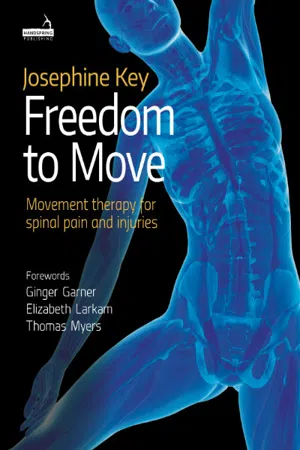
- English
- ePUB (mobile friendly)
- Available on iOS & Android
About this book
Freedom to Move is an evidence informed practical resource which provides movement therapists of all disciplines with an exercise blueprint for rehabilitating spinal pain and many related 'injuries'.
In essence, Freedom to Move describes what goes wrong in the spine and what to do about it. It integrates the applicable contemporary neuroscience around spinal movement and pain with the clinical evidence and understanding gained from the author's enquiring practice, and her exploration of various movement approaches and their contribution - or otherwise, to spinal well-being.
It examines the relationship between healthy torso structure and functional control and describes and explains the author's model of spinal dysfunction – the remediation of which forms the basis of the author's model of care for the spine, The Key Approach®.
The book's main focus is on a practical, therapeutic exercise/movement approach which addresses the common movement faults and dysfunctions observed in people with spinal pain and stiffness.
In particular, the Fundamental Patterns of control are introduced as important, innate 'key' movements which naturally provide the sound foundations necessary for a healthy spine – but which have commonly been 'lost' in the movement repertoire of people with spinal pain syndromes.
These are re-established and reincorporated into various poses, movements and stretches by way of specifically directed mindful movement explorations. The client is helped to regain more optimal function and move out of pain - with more freedom.
The approach is applicable within all industry models of teaching therapeutic movement: in the rehabilitation of spinal pain within physiotherapy, Pilates and Yoga; and in the fitness industry, for injury prevention, health promotion and optimising spinal health in exercise programmes in general.
Frequently asked questions
- Essential is ideal for learners and professionals who enjoy exploring a wide range of subjects. Access the Essential Library with 800,000+ trusted titles and best-sellers across business, personal growth, and the humanities. Includes unlimited reading time and Standard Read Aloud voice.
- Complete: Perfect for advanced learners and researchers needing full, unrestricted access. Unlock 1.4M+ books across hundreds of subjects, including academic and specialized titles. The Complete Plan also includes advanced features like Premium Read Aloud and Research Assistant.
Please note we cannot support devices running on iOS 13 and Android 7 or earlier. Learn more about using the app.
Information
Assessment: Altered movement behavior is often hiding in plain sight
5
Table of contents
- Cover
- Title Page
- Copyright
- Contents
- Foreword by Ginger Garner
- Foreword by Elizabeth Larkam
- Foreword by Thomas Myers
- Preface
- Introduction
- Glossary of terms
- Glossary of abbreviations
- Part A: Laying the groundwork for an enhanced understanding of the spine in health and disease
- Part B: Getting to work rebuilding enhanced spinal movement control
- Index